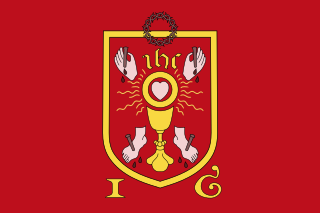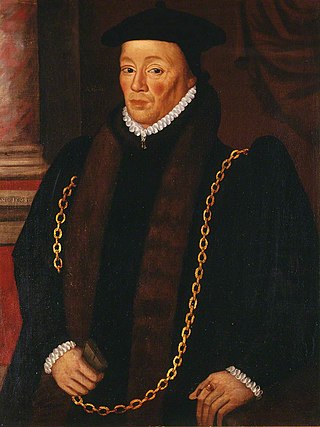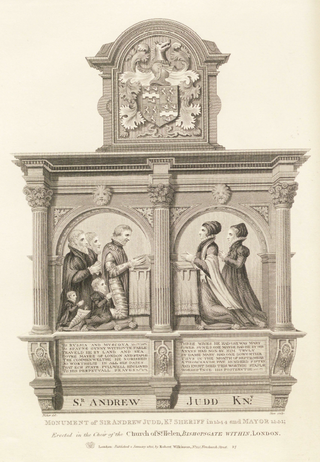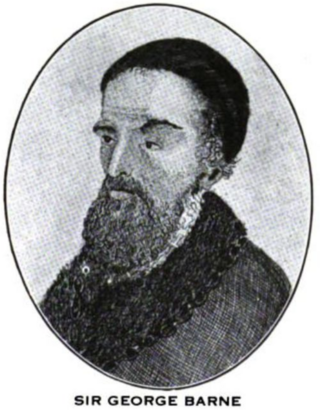
Anne of Cleves was Queen of England from 6 January to 12 July 1540 as the fourth wife of King Henry VIII. Not much is known about Anne before 1527, when she became betrothed to Francis, Duke of Bar, son and heir of Antoine, Duke of Lorraine, although their marriage did not proceed. In March 1539, negotiations for Anne's marriage to Henry began, as Henry believed that he needed to form a political alliance with her brother, William, who was a leader of the Protestants of Western Germany, to strengthen his position against potential attacks from Catholic France and the Holy Roman Empire.
John Dudley, 2nd Earl of Warwick, KB was an English nobleman and the heir of John Dudley, 1st Duke of Northumberland, leading minister and regent under King Edward VI from 1550–1553. As his father's career progressed, John Dudley respectively assumed his father's former titles, Viscount Lisle and Earl of Warwick. Interested in the arts and sciences, he was the dedicatee of several books by eminent scholars, both during his lifetime and posthumously. His marriage to the former Protector Somerset's eldest daughter, in the presence of the King and a magnificent setting, was a gesture of reconciliation between the young couple's fathers. However, their struggle for power flared up again and ended with the Duke of Somerset's execution. In July 1553, after King Edward's death, Dudley was one of the signatories of the letters patent that attempted to set Lady Jane Grey on the throne of England, and took arms against Mary Tudor, alongside his father. The short campaign did not see any military engagements and ended as the Duke of Northumberland and his son were taken prisoners at Cambridge. John Dudley the younger was condemned to death yet reprieved. He died shortly after his release from the Tower of London.
John Stokesley was an English clergyman who was Bishop of London during the reign of Henry VIII.

The Pilgrimage of Grace was a popular revolt beginning in Yorkshire in October 1536, before spreading to other parts of Northern England including Cumberland, Northumberland, Durham and north Lancashire, under the leadership of Robert Aske. The "most serious of all Tudor period rebellions", it was a protest against Henry VIII's break with the Catholic Church, the dissolution of the lesser monasteries, and the policies of the King's chief minister, Thomas Cromwell, as well as other specific political, social, and economic grievances.

Sir Thomas Cheney KG of the Blackfriars, City of London and Shurland, Isle of Sheppey, Kent, was an English administrator and diplomat, Lord Warden of the Cinque Ports in south-east England from 1536 until his death.

Sir Francis Weston KB was a gentleman of the Privy Chamber at the court of King Henry VIII of England. He became a friend of the king but was later accused of high treason and adultery with Anne Boleyn, the king's second wife. Weston was condemned to death, together with George Boleyn, Viscount Rochford, Henry Norris, William Brereton and Mark Smeaton. They were all executed on 17 May 1536, two days before Anne Boleyn suffered a similar fate.
Sir William Laxton was a Lord Mayor of London during the reign of Henry VIII, and eight times Master of the Worshipful Company of Grocers. He is the founder of Oundle School.
William Brereton, c. 1487/1490 – 17 May 1536, was a member of a prominent Cheshire family who served as a courtier to Henry VIII. In May 1536, Brereton was accused of committing adultery with Anne Boleyn, the king's second wife, and executed for treason along with her brother George Boleyn, Henry Norris, Francis Weston and a musician, Mark Smeaton. Many historians are now of the opinion that Anne Boleyn, Brereton and their co-accused were innocent.
Berwick Pursuivant of Arms in Ordinary was an English office of arms created around 1460 for service on the Scottish Marches based at Berwick-upon-Tweed. In the 16th century there was also a Herald or Pursuivant based at Carlisle on the west border.

Henry Wriothesley, 2nd Earl of Southampton, was an English peer.
Charles Wriothesley was a long-serving officer of arms at the College of Arms in London. He was the last member of a dynasty of heralds that started with his grandfather—Garter Principal King of Arms John Writhe.

The Traitors' Gate is an entrance through which many prisoners of the Tudors arrived at the Tower of London. The gate was built by Edward I, to provide a water gate entrance to the Tower, part of St. Thomas' Tower, which was designed to provide additional accommodation for the royal family.

Sir William Garrard (1518–1571), also Garrett, Gerrarde, etc., was a Tudor magnate of London, a merchant citizen in the Worshipful Company of Haberdashers, who became alderman, Sheriff (1552–1553) and Lord Mayor of London (1555–1556) and was returned as an MP for the City of London. He was a senior founding officer of the Company of Merchant Adventurers to New Lands in 1554/55, having been involved in its enterprises since the beginnings in King Edward VI's time, and for the last decade of his life was one of its permanent governors. He worked hard and invested largely to expand English overseas trade not only to Russia and the Levant but also to the Barbary Coast and to West Africa and Guinea.
Bigod's rebellion of January 1537 was an armed rebellion by English Roman Catholics in Cumberland and Westmorland against King Henry VIII of England and the English Parliament. It was led by Sir Francis Bigod, of Settrington in the East Riding of Yorkshire.

Sir Andrew Judde or Judd was a 16th-century English merchant and Lord Mayor of London. He was knighted on 15 February 1551.
Humphrey Monmouth was an English merchant in London who was an acquaintance of Bible translator William Tyndale. Monmouth was a wealthy member of the Drapers' Company and served as an alderman and sheriff of London from 1535 to 1536.

Sir William Hewett was a prominent merchant of Tudor London, a founding member and later Master of the Worshipful Company of Clothworkers of London as incorporated in 1528, and the first of that Company to be Lord Mayor of London, which he became in the first year of the reign of Queen Elizabeth I. His career arched across the first four decades of the Company's history, and drew him inexorably, if sometimes reluctantly, into the great public affairs of the age.

Sir George Barne was an English businessman in the City of London who was active in developing new trading links with Russia, West Africa and North America, far outside what had been traditional English trading patterns. Created a knight in 1553, he served as Sheriff of London and Lord Mayor of London. He was the father of Sir George Barne and grandfather of Sir William Barne. Nicholas Culverwell was probably a nephew.

Mary I of England (1516–1558) and Philip of Spain married at Winchester Cathedral on Wednesday 25 July 1554.

The coronation of Edward VI as King of England and Ireland took place at Westminster Abbey, London, on 20 February 1547. Edward ascended the throne following the death of King Henry VIII.











